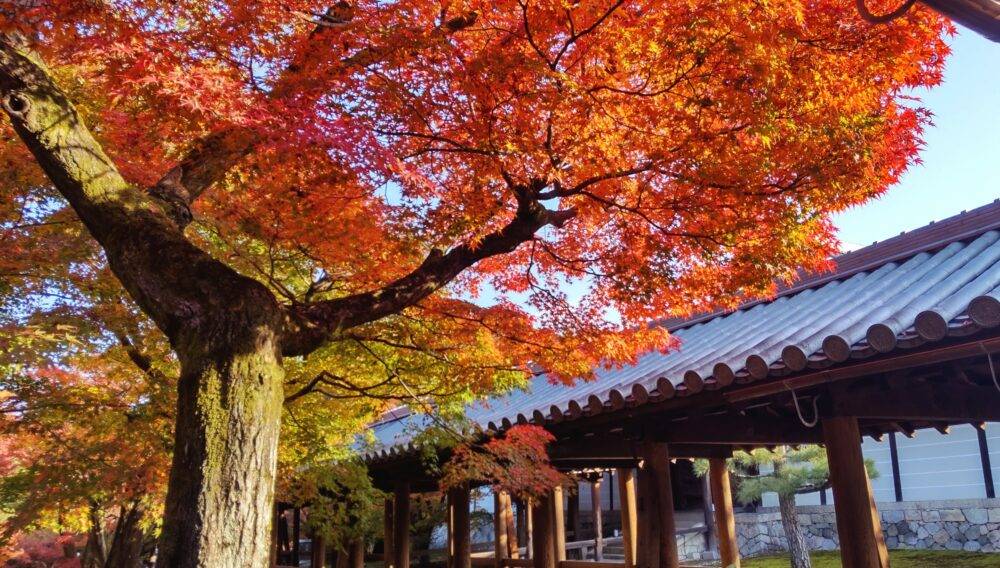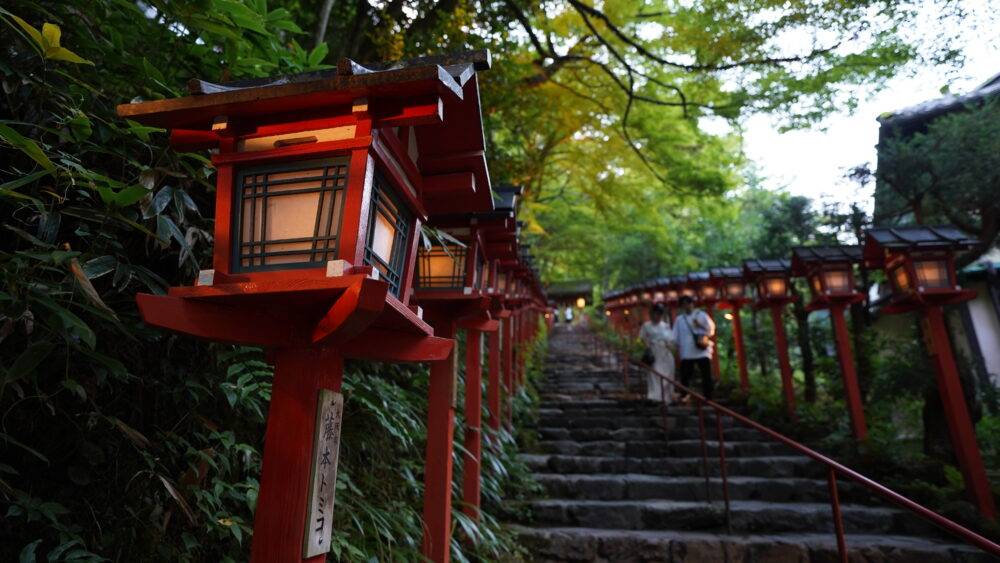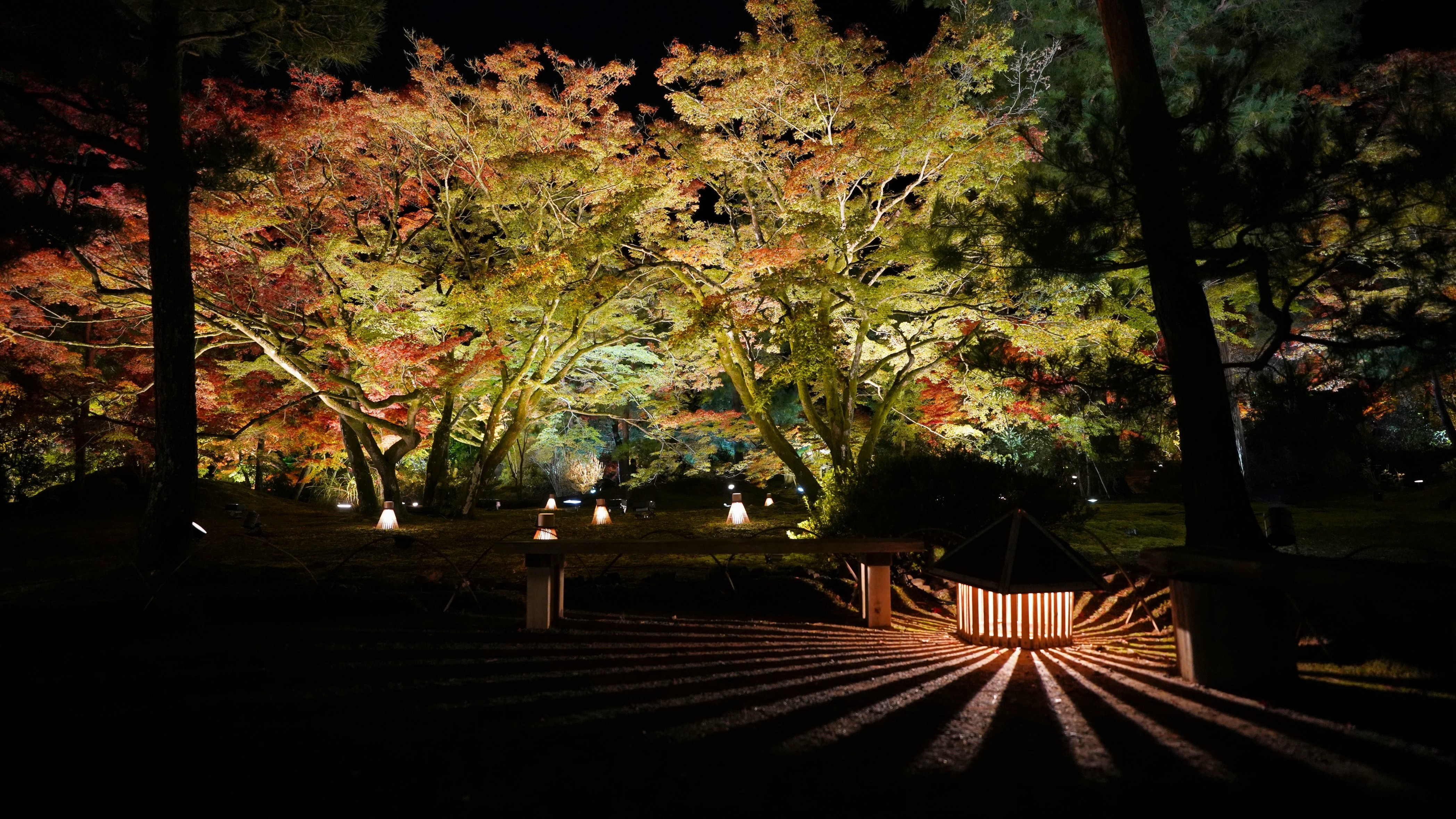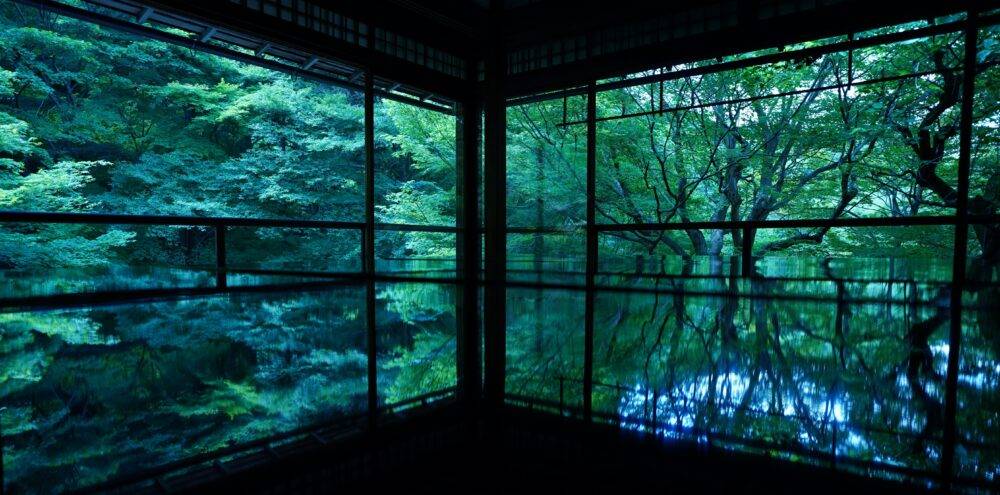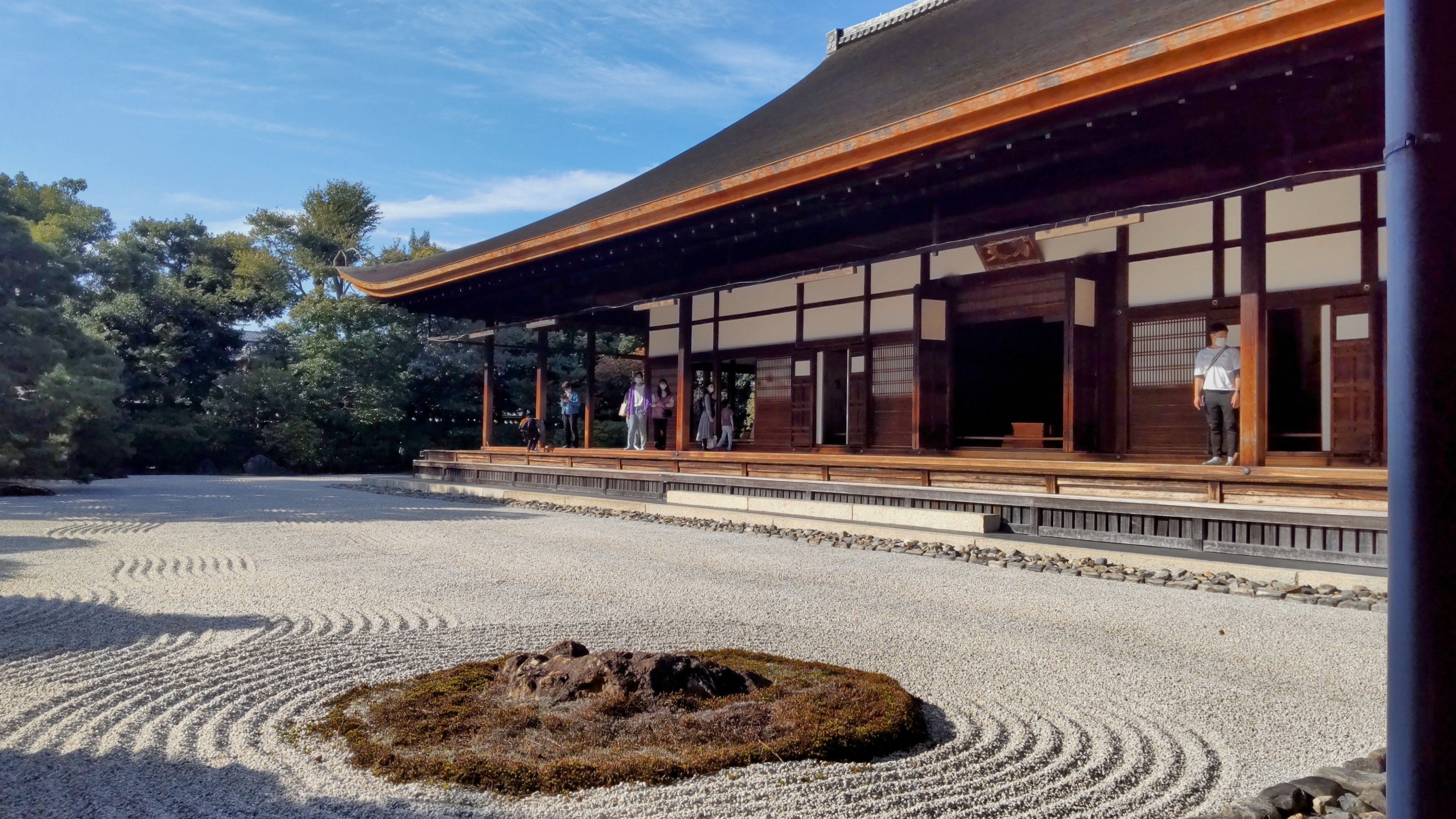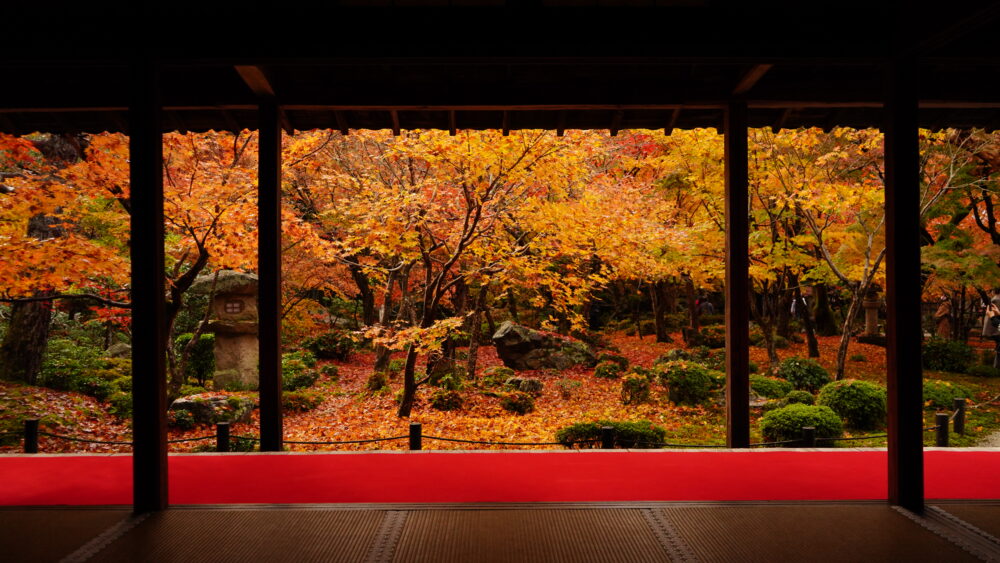Jonangu Shrine| All You Need to Know in 2025
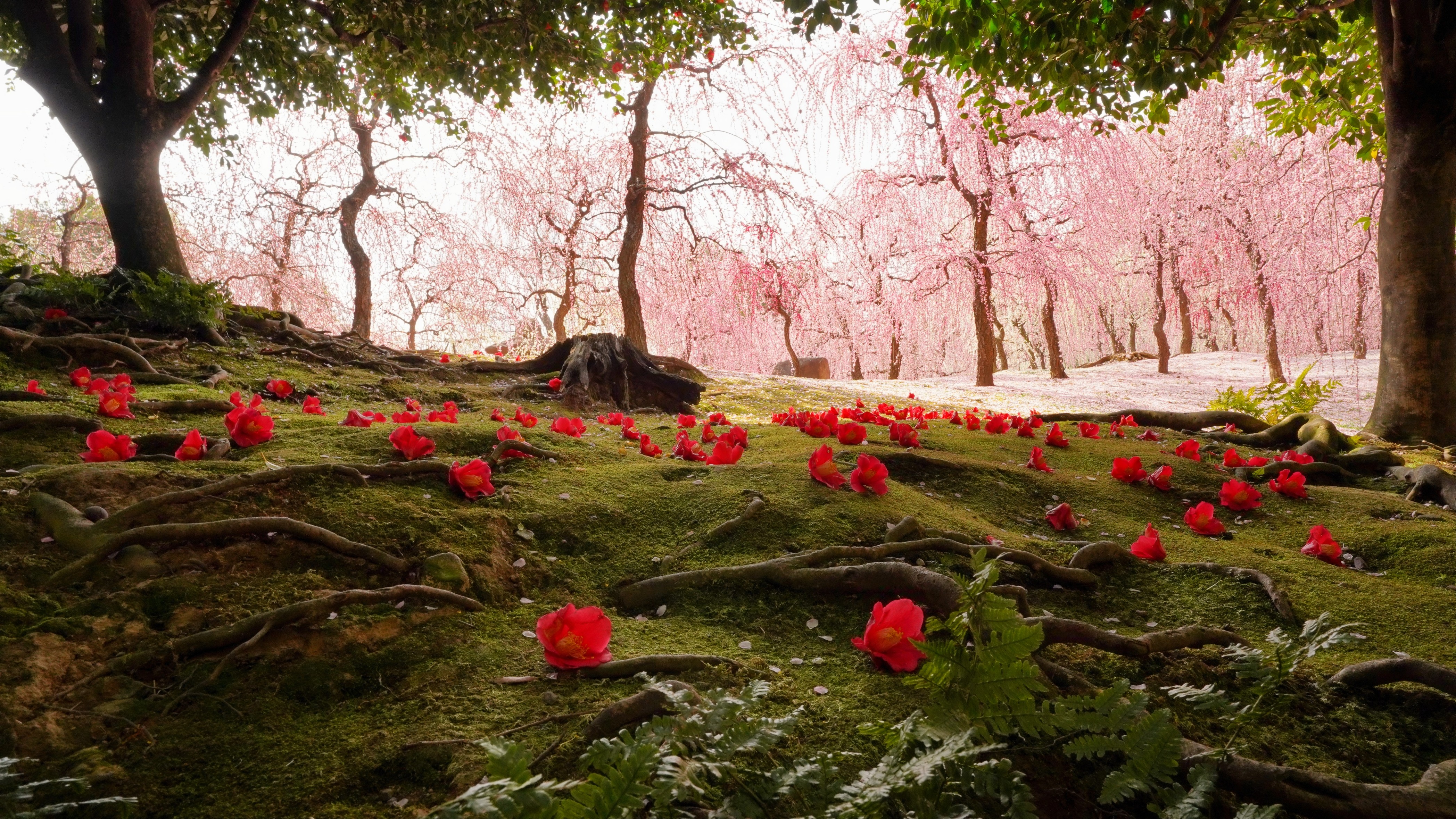
Jonangu Shrine has five extensive gardens that are famous for their seasonal blooms. The sight of the weeping plum trees in full bloom and the fallen camellia blossoms in March is particularly stunning. Before you visit, it’s helpful to know everything you need to know to enhance your experience.
History
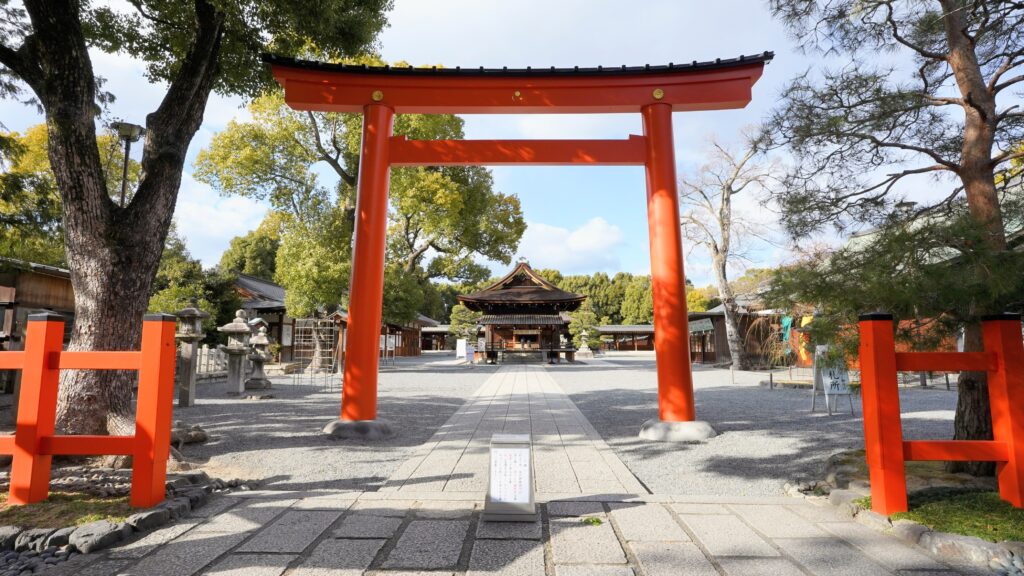
In 794, the capital was moved to Heian-kyo. At the time of the relocation, shrines were venerated in each direction, and in the south, Jonan Daijin was enshrined, leading to the establishment of Jonangu as the guardian shrine to do Hoyoke.
Jonangu Shrine was also a shrine established by nobles for “Hoyke”.
Hoyoke is a custom often practiced in the Heian period in which nobles would leave the night before their usual departure, travel in a different direction, stay overnight, and leave for their destination the next morning (to avoid traveling in an unlucky direction).
In the late Heian period, the emperors Shirakawa and Toba built imperial villas around Jonangu Shrine, making it the base of their monastic government. As a result, this shrine continued to be revered as an important shrine guarding the imperial villas.
In 1221, Emperor Go-Toba recruited archers from a horse archery contest held at Jonangu Shrine to suppress the Hojo clan, leading to the Jokyu War.
Jonangu Shrine was devastated by various wars, including the Onin War (1467-1477), but was rebuilt during the Edo period.
The Battle of Toba-Fushimi began with the roar of cannons fired by the Satsuma clan as they approached Jonangu Shrine. The festival featured a procession of portable shrines, mounted archery, and horse racing, and these traditions continue today as the Jonan Festival.
Rakusui-en Garden
Jonangu Shrine has a garden called Rakusuien, which was designed in 1960 by Kinzaku Nakane, who is famous for designing the Tensin-en Garden at the Boston Museum.
It consists of five gardens, each with a different theme. In order, they are: “Spring Mountain”, “Heian Garden”, “Muromachi Garden”, “Jonan Rikyu Garden”, and “Momoyama Garden”. These gardens recreate different periods of Japanese history and are designed to be enjoyed throughout the four seasons.
Spring Mountain Garden
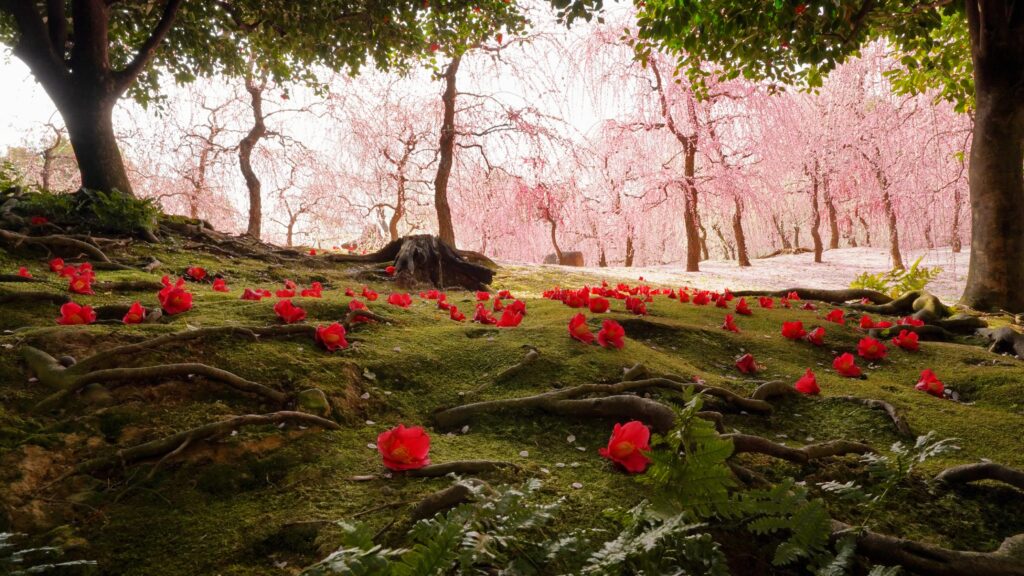
Spring Mountain Garden features a gentle, man-made hill with a variety of spring blooming trees, 150 weeping plum trees, and approximately 400 camellias of 150 different varieties.
The highlight is the breathtaking sight of fully blooming weeping plum trees and fallen red camellias scattered across the emerald mossy hill. The sloping terrain ensures that the camellias face visitors, creating a truly enchanting scene.
Weeping plum trees bloomed a little earlier than usual in 2024, from mid-February to early March, due to the mild winter. In a typical year, they bloom from late February to mid-March.
Heian Garden
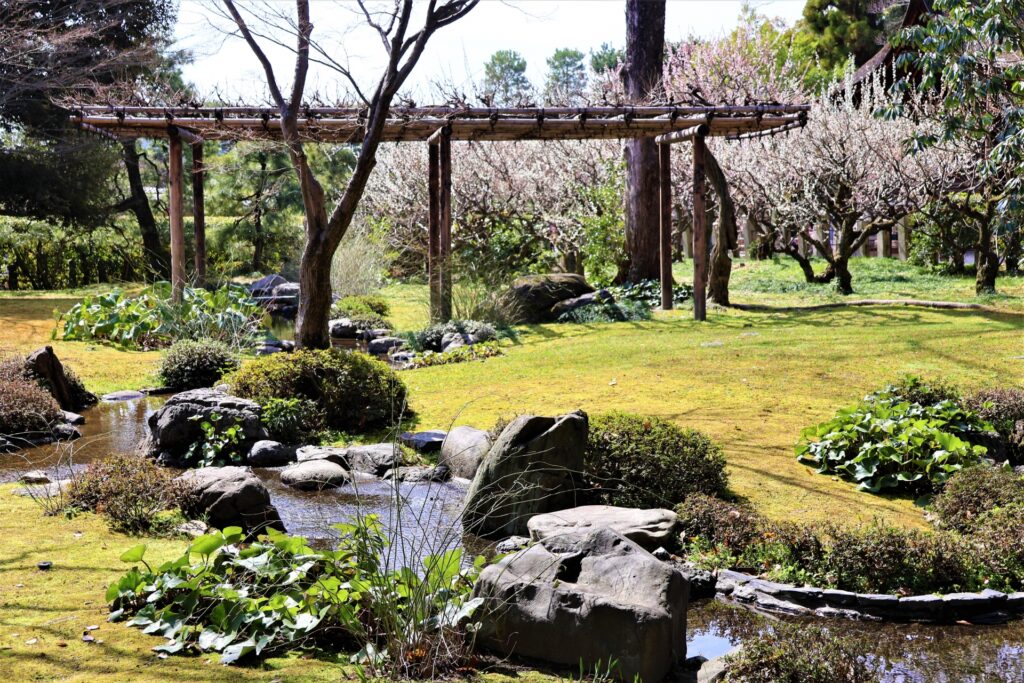
Heian Garden is a recreation of a garden from the Heian period (794-1185). It replicates the gardens of aristocratic residences and Shinden-zukuri style temples of the period, which typically had a “Shinden” (main hall) on the north side of the property and a pond facing south.
A distinctive feature of these gardens is the “Kyokusui,” an artificial winding stream influenced by Chinese garden designs. During the Heian period, the aristocratic class enjoyed a popular pastime known as “kyusu no utage” (literally, “feast by the winding stream”), where participants would float cups of sake down the stream while composing and reciting waka poems.
Today, Jonangu Shrine continues this tradition with an annual event on April 29th, where people dressed in Heian period attire gather to watch seven poets compose waka poems.
Jonangu Garden
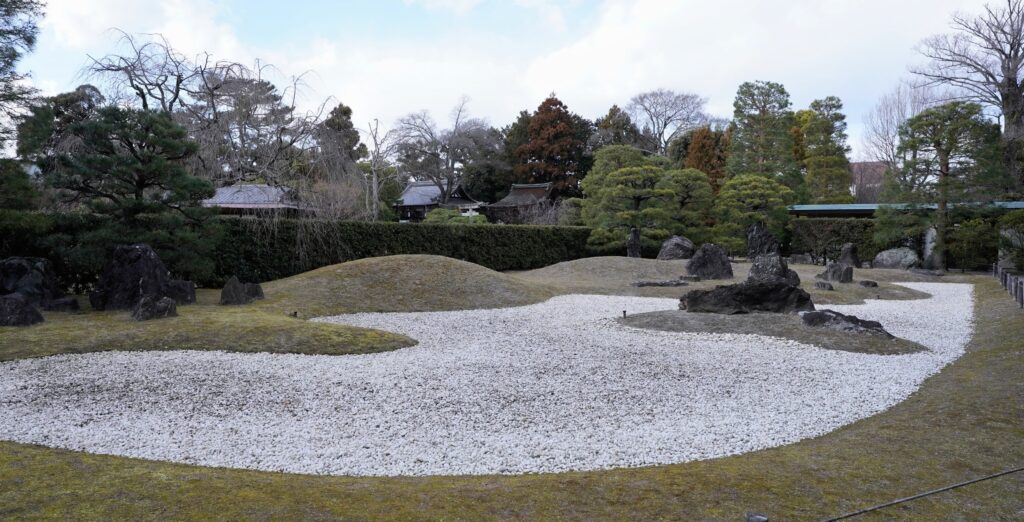
Jonangu Garden is a serene karesansui (dry Japanese) garden meticulously designed with carefully arranged stones, lush green lawns, and white gravel. This garden beautifully captures the essence of the Kyoto landscape, with flat stones representing the Kamo River and a field of white stones symbolizing the pond of the former imperial villa. Towering black pine trees add a touch of grandeur and elegance to this exquisite garden.
Muromachi Garden
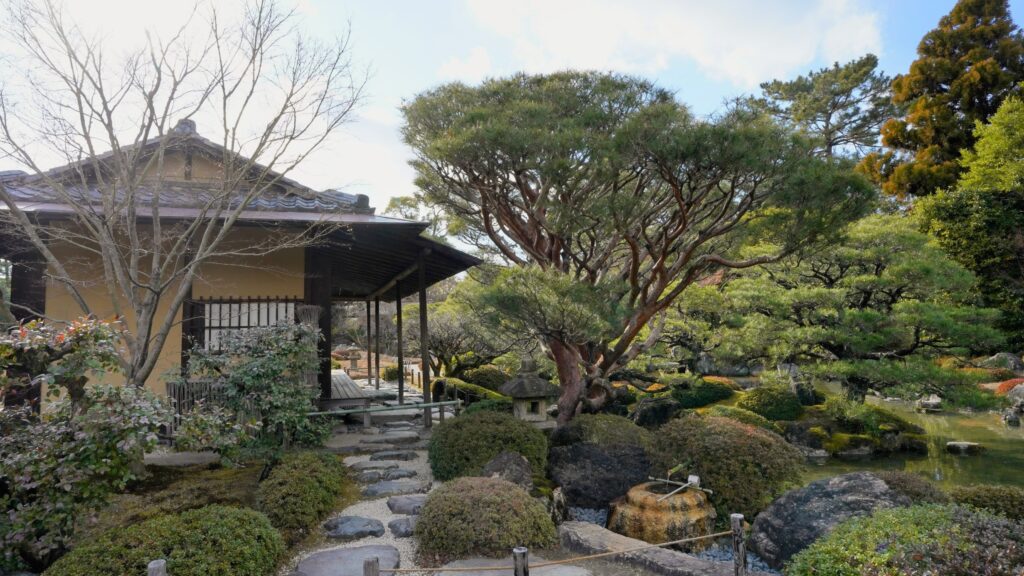
During the Muromachi period (1336-1573), the tea ceremony flourished and tea houses were built in various locations. Jonangu also has its own teahouse called Rakusuien, which is located between the Muromachi and Momoyama gardens. In addition, over 80 species of plants mentioned in The Tale of Genji by Murasaki Shikibu have been cultivated here, creating a garden that embodies the changing seasons experienced by Hikaru Genji.
Momoyama Garden
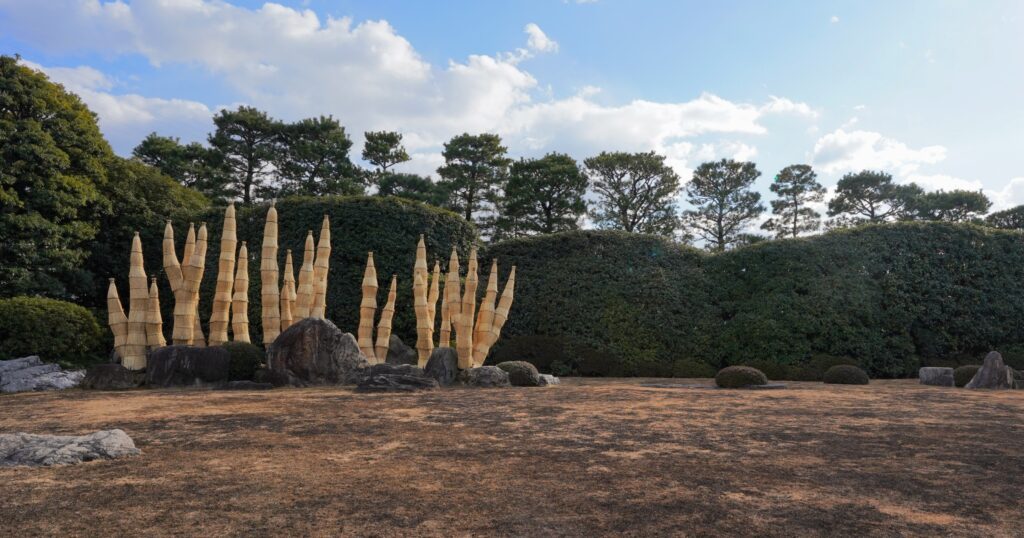
The Momoyama period (1574-1603) was a time of active trade between Japan and other Asian and Western countries. The Karesansui Garden reflects this era with a design that incorporates elements of both Japanese and Western aesthetics. The expansive lawn symbolizes the Pacific Ocean, while carefully placed stones represent the islands off the coast of Japan. The centerpiece of the garden is a majestic sago palm, a symbol of the tropics. Because of its tropical origins, the sago palm is wrapped in straw during the cold winter months to protect it from the harsh climate.
Buildings
Jonangu Shrine has a history spanning nearly 1200 years, and as such, it boasts numerous historic buildings.
Main Hall
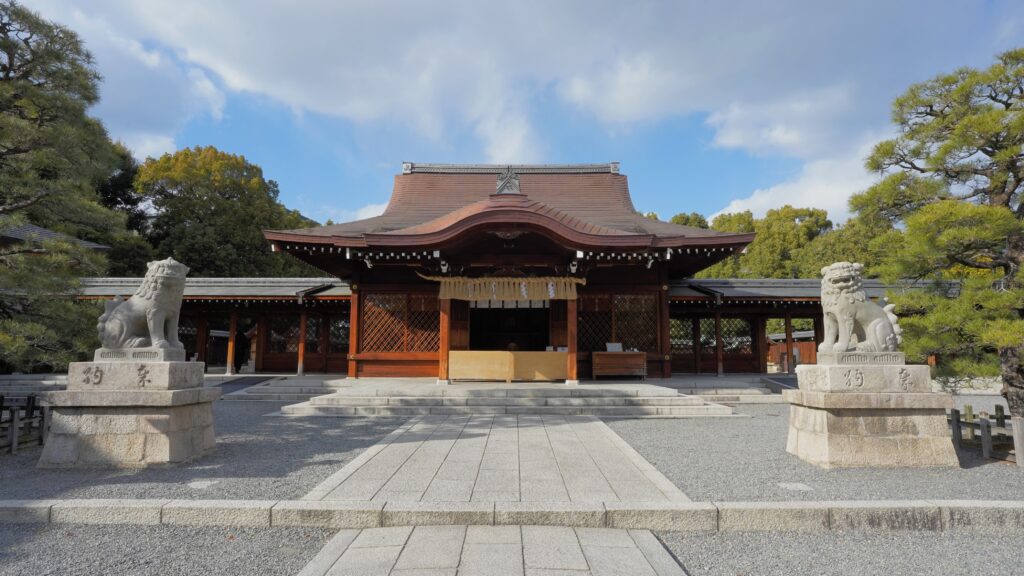
The main hall of Jonangu Shrine is a unique structure consisting of three connected buildings. The front hall and the prayer hall share a roof, creating a projecting section above the front steps. The main hall is at the far end, connected to the front hall by two wing-like corridors on either side.
Temizuya (ablution pavilion)
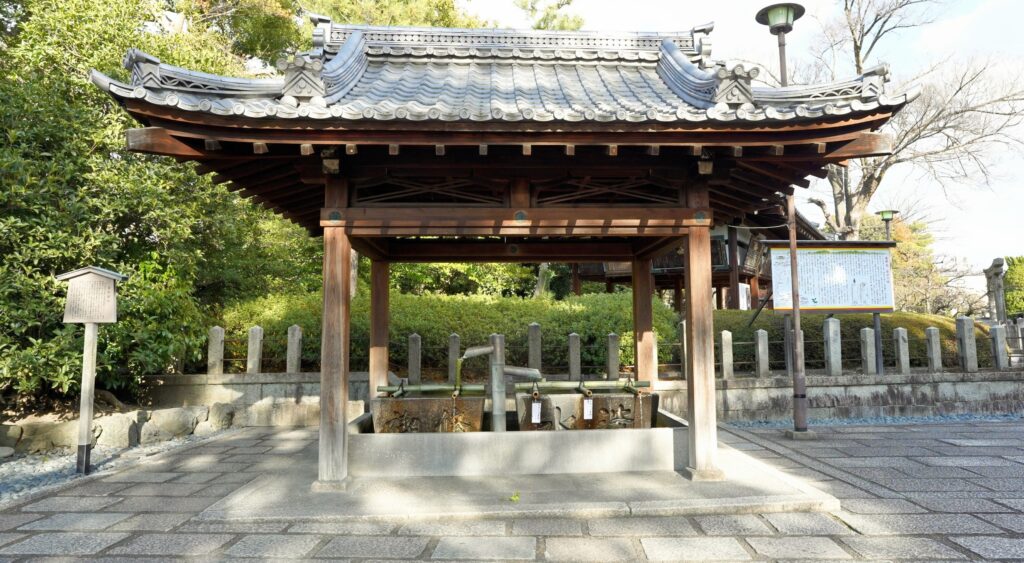
Temizuya at Jonangu Shrine is famous for its spring water known as “Kikusu Wakamizu”. There is a historical record that Emperor Reigen’s pain was alleviated after drinking this water. Today, it is freely available as drinking water.
Kagura Hall
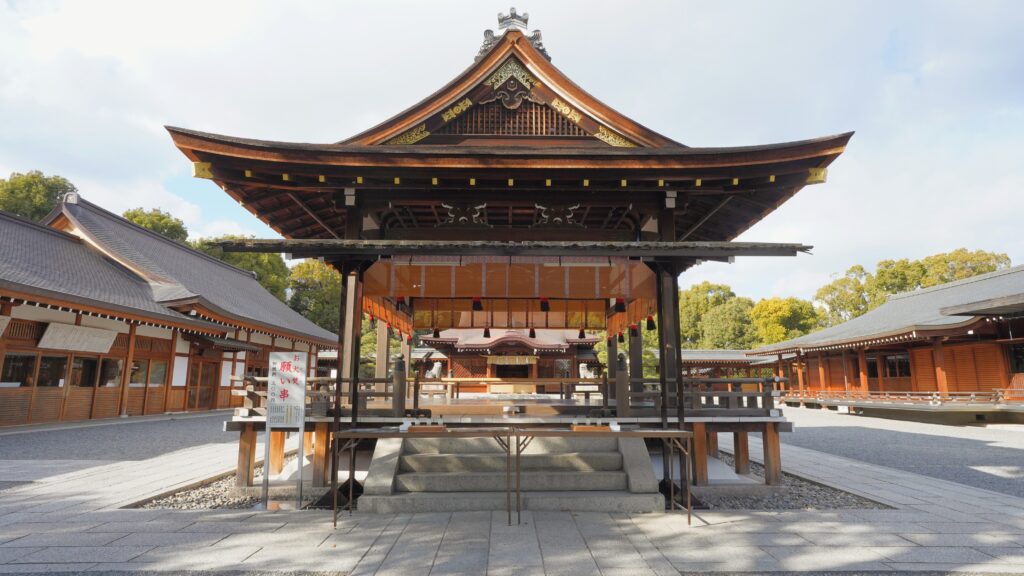
Kagura Hall, built in 1996, is modeled after the Shinden-zukuri style of aristocratic residences in the Heian period. Throughout the seasons, shrine maidens perform sacred dances for the gods in this hall.
Suijin statues reproduce the appearance of suijin (divine guardians) from the Heian period. The statue on the right, with a long beard and open mouth, and the statue on the left, a young man with his mouth closed, both stare fiercely, fulfilling the role of subduing demons and preventing outsiders from approaching the sacred space before the deity.
Suijin statues
Suijin statues reproduce the appearance of suijin (divine guardians) from the Heian period. The statue on the right, with a long beard and open mouth, and the statue on the left, a young man with his mouth closed, both stare fiercely, fulfilling the role of subduing demons and preventing outsiders from approaching the sacred space before the deity.
Information
Hours and Fees
Open Hours
9:00 a.m. – 4:30 p.m. (Last entry is at 4:00 p.m.)
Entrance Fee
Admission to Jonangu Shrine grounds is free.
| Period | Price of Gardens |
|---|---|
| January.1st to February.17th | Junior high school students and above : 800yen Elementary school students : 500yen |
| February.18th to March.22nd *Only Spring Mountain Garden and Heian Garden are open | Junior high school students and above : 1,000yen Elementary school students : 600yen |
| March.23rd to June.30th | Junior high school students and above : 800yen Elementary school students : 500yen |
| July.1st to August.31st *Only Spring Mountain Garden and Heian Garden are open | Junior high school students and above : 300 yen Elementary school students : 300 yen |
| September1st to December.31st | Junior high school students and above : 800 yen Elementary school students : 500yen |
Weeping Plum and Camellia Festival
The Weeping Plum and Camellia Festival will be held at Jonangu Shrine. In 2025, it will be held from February 18 to March 22.
During this period, maidens perform Kagura dances on the front stage of the Kagura Hall: 10:00 am on weekdays, 10:00 am and 3:00 pm on weekends and holidays. They wear plum blossoms on their heads and hold plum branches in their hands, making them very beautiful.
Special goshuin (shrine stamps) with weeping plum and camellia motifs are issued.
Tsubaimochi (camellia-shaped mochi), a confection, is sold. This confection is a reproduction of a confection served at the residences of the nobility in the Heian period. It is a confection in which mochi (rice cake) filled with bean paste is sandwiched between the leaves of a camellia.
Adress
〒612-8459 Kyoto, Fushimi Ward, Nakajimatobarikyucho, 7
How to get there
The most common way to get from Kyoto Station to Jonangu Shrine is to combine public transportation with walking.
- From Kyoto Station, take the Karasuma Line subway (Green Line) to Takeda Station, and it’s about an 18-minute walk from there.
- Another option is to take the Kintetsu Line (Yellow Line) from Kyoto Station to Takeda Station on a Yamato-Saidaiji-bound train.
While trains are the most reliable way to get there on time, the walk can be a bit long. During less crowded times (outside of March, April, November, and December), consider taking a taxi or using buses for a more direct and comfortable trip. - If you’d prefer to take the bus, bus No. 19 from the Hachijo-guchi exit of Kyoto Station will take you to Jonangu bus stop, a short 1 – minute walk from the shrine.
- It takes about 17 minutes by taxi from the south exit of Kyoto Station.
Resources and Links
Official Website
Jonangu Shrine(English Text)
